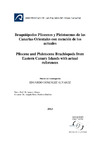Please use this identifier to cite or link to this item:
https://accedacris.ulpgc.es/jspui/handle/10553/11152
| DC Field | Value | Language |
|---|---|---|
| dc.contributor.advisor | Alonso Bilbao, Ignacio | - |
| dc.contributor.advisor | Meco Cabrera, Joaquín Francisco | - |
| dc.contributor.author | González Álvarez, Eduardo Javier | - |
| dc.date.accessioned | 2014-01-09T03:31:18Z | |
| dc.date.accessioned | 2018-05-15T10:47:38Z | - |
| dc.date.available | 2014-01-09T03:31:18Z | |
| dc.date.available | 2018-05-15T10:47:38Z | - |
| dc.date.issued | 2013 | en_US |
| dc.identifier.uri | https://accedacris.ulpgc.es/handle/10553/11152 | |
| dc.description | Máster en Oceanografía | en_US |
| dc.description.abstract | The study of fossil fauna and the available literature, allows us to give an interpretation of paleoclimatic character to the presence of brachiopods, associated with their fossil state to weather conditions very different that nowadays, being equivalent to the present tropical regions of the planet.It is studied, therefore, the faunal content from the fossiliferous sedimentarydeposits of Pliocene (5-3 My) and Pleistocene (3 Myr-10 kyr) age present in Gran Canaria, Fuerteventura and Lanzarote -eastern Canary Islands- paying special attention to those observed fossil brachiopods. It has undertaken a review of previous work and the study of the deposits of Pliocene and Pleistocene age, as well as the revision of the fossil collections of the Laboratory of Paleontology at the University of Las Palmas de Gran Canaria. This has allowed the identification of 4 species of fossil brachiopods: Terebratula sinuosa(Brocchi 1814), Lacazella mediterranea(Risso 1826), Terebratulina caputserpentis (Zbyszewski, 1957) and Thecidium cf. digitatum(Sowerby 1823). These fossils have been identified in outcrops of Pliocene age from the eastern Canary Islands, described and illustrated in the work of Meco et al. (2005) and in outcrops interpreted as coming from an marine event of great energy or tsunami in Piedra Alta, Lanzarote, belonging to Marine Isotope Stage 11 (MIS 11) in circa 480 kyr. Furthermore, in order to compare the fossil brachiopods with existing, it has been defined a reference collection with actual specimens obtained from the pickup of surface sediment samples made in Gran Canaria and Hierro, identifying 3 species: Argyrotheca barrettiatia(Davidson, 1866), Megerlia truncata(Linaeus 1767) and Pajaudina atlantica (Logan 1988). | en_US |
| dc.format | application/pdf | es |
| dc.language | eng | en_US |
| dc.rights | by-nc-nd | es |
| dc.subject | 2416 Paleontología | en_US |
| dc.subject.other | Paleobiología-Plioceno | en_US |
| dc.title | Estudio de los braquiópodos fósiles del neógeno y pleistoceno de las canarias orientales : citas actuales | en_US |
| dc.title.alternative | Pliocene and Pleistocene brachiopods from Eastern Canary Islands with present references | en_US |
| dc.type | info:eu-repo/semantics/masterThesis | en_US |
| dc.type | MasterThesis | en_US |
| dc.bustreaming | 23596 | es |
| dc.compliance.driver | 1 | es |
| dc.contributor.departamento | Física | en_US |
| dc.contributor.facultad | Facultad de Ciencias del Mar | en_US |
| dc.identifier.absysnet | 692922;692290 | es |
| dc.identifier.crisid | - | |
| dc.investigacion | Ciencias | en_US |
| dc.rights.accessrights | info:eu-repo/semantics/openAccess | es |
| dc.type2 | Trabajo final de máster | en_US |
| dc.description.notas | Acto de defensa celebrado en la Sala de grado de la Facultad de Ciencias del Mar el 20 de diciembre de 2013. Actúa como presidenta del tribunal María Dolores Gelado Caballero, como Secretaria, Inmaculada Menéndez González y como vocal Antonio González Ramos. | en_US |
| dc.utils.revision | Sí | en_US |
| dc.identifier.matricula | TFT-29448 | es |
| dc.identifier.ulpgc | Sí | en_US |
| dc.contributor.buulpgc | BU-BAS | en_US |
| dc.contributor.titulacion | Máster Universitario en Oceanografía | es |
| item.grantfulltext | open | - |
| item.fulltext | Con texto completo | - |
| crisitem.advisor.dept | GIR IOCAG: Geología Aplicada y Regional | - |
| crisitem.advisor.dept | IU de Oceanografía y Cambio Global | - |
| Appears in Collections: | Trabajo final de máster | |
Page view(s)
69
checked on Aug 12, 2023
Download(s)
105
checked on Aug 12, 2023
Google ScholarTM
Check
Share
Export metadata
Items in accedaCRIS are protected by copyright, with all rights reserved, unless otherwise indicated.
